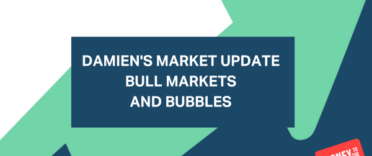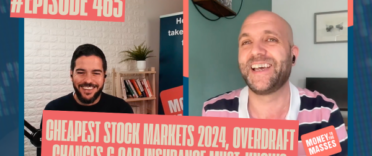The 142nd episode of my weekly YouTube show where I discuss what is happening in investment markets and what to look out for. This week I explain how the impact of the ongoing Ukraine invasion is impacting investment markets.
Each show lasts between 5-10 minutes and is aimed at DIY investors (including novices) seeking contemporary analysis to help them understand how investment markets work.
Subscribe to my YouTube channel to receive my weekly analysis of investment markets or alternatively, you can listen via my weekly Midweek Markets podcast below.
Midweek Markets weekly podcast
Other ways to watch, listen and subscribe
You can listen to other episodes and subscribe to the show by searching 'Money to the Masses' on Spotify or by using the following links:
Abridged transcript - Midweek Markets episode 142
A week on from last week’s show and unfortunately it means that we are a week into Russia’s invasion of Ukraine. In terms of investment markets uncertainty remains and we are seeing incredible levels of volatility in certain assets as investors struggle to price in the impact of the war and the corresponding sanctions on Russia on the global economy.
February closed with every major stock market in the red as a result of the increased uncertainty over the path of inflation and central bank responses but also the path of the war in Ukraine. During February the German DAX was the hardest hit of the major western stock markets falling 6.53% during the month. The German economy has a significant reliance on Russian gas supplies, while its stock market index has a lack of energy companies within, which have been the chief beneficiaries of rising energy prices.
The opposite can be said for the UK which is why the FTSE 100 was down only 0.08% during February. To give the moves some context the MSCI ACWI was down - 2.74%, the S&P 500 fell -3.14%, the FTSE Eurofirst 300 was down -3.23% the Nasdaq 100 was down -4.64%.
If we zoom out and look at the year to date returns of the various indices the established trends have continued with US stocks faring the worst (the Nasdaq 100 is down -12.72%, having been as low as -17.22%). But the situation in Ukraine has seen European stocks now dragged lower with the DAX now down -11.87% year to date. Once again the standout performer is the FTSE 100 which is incredibly still up 0.61% year to date.
As the situation in Ukraine continues to escalate we’ve seen increased levels of volatility across asset classes. Having revisited January’s intra-day of 4222 the S&P 500 is now finding some support around the 4300 level. Right now the index seems to be trading in the range between 4250 and the 200 day moving average of 4463. At the moment the S&P 500 sits at 4386. Equity markets globally continue to be volatile, reacting to the newsflow out of Ukraine.
Even at a sector level we are still seeing big swings, with investors rotating in and out of defensive sectors into more cyclical ones and back again. It means that placing aggressive bets right now leaves you exposed to the potential for the market to move against you. We are seeing short squeezes, which then fade resulting in strong rallies that eventually are sold into and dissipate. The market is looking for a catalyst for the next strong move higher or lower.
But it's not just in equity markets where we’ve seen aggressive price swings. We’ve seen it in bond and commodity markets this week too. On Tuesday the 10 year US treasury yield sank from 1.88% to below 1.70% as the scale of new international sanctions against Russia were revealed. Fears that the long term effect of these sanctions would be to hurt global economic growth, as well as a dash for safety after Russia’s nuclear threats, saw bond prices soar (and yields correspondingly fall). It felt like a return to the historically negative correlation between bonds and equities, where there is a tendency for them to move in opposite directions and therefore provide some diversification in your portfolio. While this hasn’t been the case so far in 2022, with the returns from a typical bond/equity portfolio in negative territory, bonds finally provided a boost to your portfolio in one of the biggest one day moves in bond markets for years.
Yet just 24 hours later, testimony from US Federal Reserve Chair, Jerome Powell, that the Fed would indeed pursue an interest rate rise in March, despite the war in Ukraine, refocused investors’ minds on the macroeconomic backdrop.
As a result of the war in Ukraine the market had scaled back its bets on the number of interest rate rises the Fed would implement in 2022, falling from 6-7 to 4-5. But this reversed following Powell’s comments and an upward revision on the previously announced number of jobs added to the US economy in January. The 10 year US treasury yield rebounded to 1.86% in a matter of hours, leading bond funds lower once again at the same time as equity markets continued to show signs of weakness.
Elsewhere commodity prices have soared, with the price of Brent crude rising to $120 a barrel, which marks a 50% rise so far in 2022 and the highest level in 8 years. Wheat prices too have soared, which is increasing inflationary pressure around the world.
The haven asset of gold sits at $1933 per ounce, still above that key $1900. Bitcoin has rallied back above that key $41,000 seeming to decouple, for now at least, from the plight of US tech stocks. The moves in bitcoin give you a sense of how some investors are already calling the bottom for equity markets and other risk assets. Yet market bottoms are rarely formed in a single moment of time but often follow a period of consolidation. It’s far too early to be certain of such things, especially when so much is uncertain with regard to the situation in Ukraine or global central bank policy decisions. Whatever tea leaves investors are reading in an attempt to divine the future, some will be positive others negative. For example, there has been a bullish divergence between the Relative Strength Index on the S&P 500 and the index itself. To understand what I mean by this listen to Money to the Masses podcast episode 348. Yet at the same time the Nasdaq 100 has just produced the first death cross in two years. This is where the 50 day moving average crosses down through the 200 day moving average, and is seen as an omen of worse things to come by some sections of the investment world.
Is it even important to catch the bottom of a market? Is it not better to avoid a potential bear market rally, than to miss out on the start of a bull market rally? That’s for individual investors to decide. But for now where we go from here is still very uncertain.




